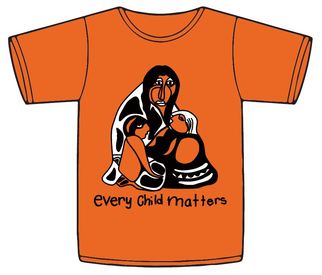This video was shared with my school district at our latest Aboriginal Focus Day. The points shared in this video for fairness, sharing and teaching our history with those who have recently come to Canada are important steps to Reconciliation. Taking action to create ReconciliACTION is important because it is 2018 and this knowledge needs to be shared.
Author Archives: KENDRAGAUTHIER
Post 4- “Teach the Indian What Law Is”
While there are many articles available focussing on what residential schools were and the pain and hardship encountered by the survivors, this article highlights what the Government’s goal was for Residential Schools and how they would achieve it. Having a view point from the government is important to providing a balanced view of Residential Schools.
Post 3- Orange Shirt Day

http://www.orangeshirtday.org/
Hearing Phyllis Webstad speak to students in SD28 just over a week ago was inspirational. Hearing her read and share her story, listening to the students asking questions, and hearing about her hopes for Orange Shirt Day and the possibility of being a holiday with Jesus (Christmas) and a Queen (Victoria Day), was inspirational. If you haven’t already checked out this website, I highly recommend it, but if you ever have a chance to listen to Phyllis share her story, you do not want to miss out.
Post 2 – Project of Heart
https://www.bctf.ca/HiddenHistory/
This resource is an excellent tool for developing my own understanding of Residential Schools and sharing pictures and stories with my students. The stories are from real people, the pictures are of real places, and helping students understand that Residential Schools are real creates deeper connections.
Post 1 – Blanket Exercise
I participated in my first blanket exercise. I was killed by small pox. My co-worker was taken from her land and moved to a Residential school. Another colleague survived Residential Schools but later died due to the negative impact it had on her life.
These experiences are not our own, but were lived by us during our last Non-Instructional Day. The Blanket Exercise shares First People’s history from across Canada in a unique way. I began to better understand what it meant to be killed by a disease I had no control over, I watched people be removed form their land, to be taken to Residential schools. This experience is one I want to share with my classes in the future.
Post 5- Decolonizing a Classroom
http://emergingindigenousvoices.ca/project/decolonizing-classrooms/
This article shares some of the challenges when decolonizing classrooms. We must be cautious that we are not having a few token pieces of First Nations culture in our classroom, because these are not authentic and will not represent the student body. By embedding First Nations culture into lessons and teaching, we will not offend through tokenism, but will engage all students.
Post 4- Decolonizing the Curriculum
CBC Beyond Beads and Bannock – Indigenous Curriculum
Listening to Deering’s interview with the CBC about decolonizing her teaching and classroom was really inspiring. Her classroom decolonization began when she introduced the First Peoples Principles of Learning to her students. By allowing students to question her and her teaching methods and providing them with inquiry projects, she has created a more holistic learning environment. A major challenge I have found in my own practice is finding support and being able to support others who are working to indigenize their classroom, their courses, and their school.
Post 3- First Peoples Principles of Learning
This week I have become more inspired by the First Peoples Principles of Learning (FNESC). I appreciate how this describes what learning is and the emphasis on relationships and what learning involves. The knowledge shared in this poster is great, but the broad reach of it can be daunting when considering how to utilize this information when creating unit plans and a classroom culture. Being aware of how our own experiences, beliefs and identities impacts our classrooms and students is an important first step to embracing these principles.

Post 2- Burn Your Village to the Ground
This video was shared with me around Thanksgiving, a holiday that often celebrates colonization and brings about stereotypical images of when the “Pilgrims and Indians sat down together”. The truth about what happened after the Europeans arrived and colonization began is shared in this song. The uncomfortable feeling this song gave me helped me realize that I have not done enough in my own teaching surrounding the truth of what has happened to our First People.
Post 1- Connections to the Land
Katjaqnaaq
“Katjaqnaaq, as much a feeling as an expression, reveals a depth of emotion and connection to a place of incredible beauty and significance. Uttered as a sigh, it can mean “ah – I am happy here, I am part of something.” As a joyful exclamation, it can mean “oh, what a beautiful place!” However it is used, it evokes connectedness to one’s surroundings and a sense of peace and meaning.” (Nunavut Parks and Special Places and the Government of Nunavut – Department of Environment)
This word and definition found on Nunavut Parks website is a powerful word for me. In Module 3 we have been discussing the role of elders and the connections to the land and how youth have been finding their own place. This word sums up a lot of my feelings about Module 3. I am happy here, I am connected to my surroundings, and I am realizing how beautiful the online community and interactions I am having through ETEC 521 truly are.